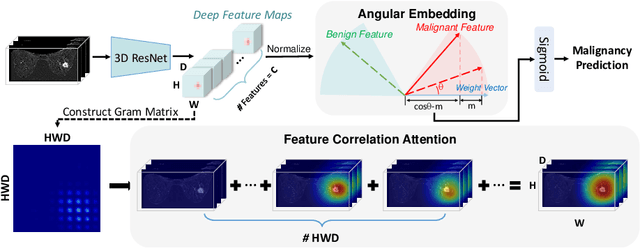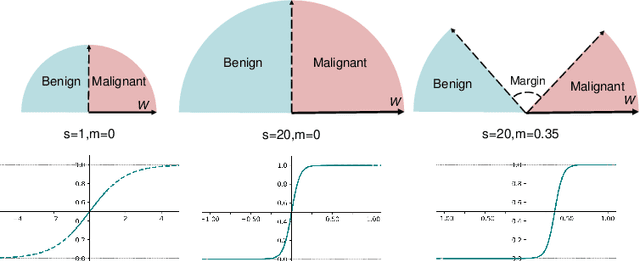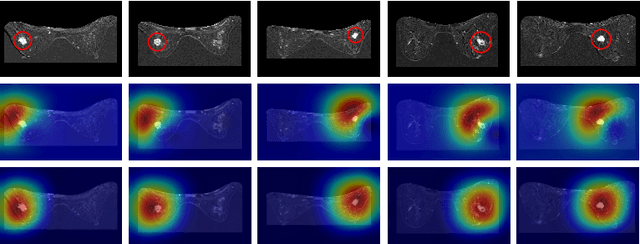Juan Zhou
Large-scale Multi-sequence Pretraining for Generalizable MRI Analysis in Versatile Clinical Applications
Aug 10, 2025Abstract:Multi-sequence Magnetic Resonance Imaging (MRI) offers remarkable versatility, enabling the distinct visualization of different tissue types. Nevertheless, the inherent heterogeneity among MRI sequences poses significant challenges to the generalization capability of deep learning models. These challenges undermine model performance when faced with varying acquisition parameters, thereby severely restricting their clinical utility. In this study, we present PRISM, a foundation model PRe-trained with large-scale multI-Sequence MRI. We collected a total of 64 datasets from both public and private sources, encompassing a wide range of whole-body anatomical structures, with scans spanning diverse MRI sequences. Among them, 336,476 volumetric MRI scans from 34 datasets (8 public and 26 private) were curated to construct the largest multi-organ multi-sequence MRI pretraining corpus to date. We propose a novel pretraining paradigm that disentangles anatomically invariant features from sequence-specific variations in MRI, while preserving high-level semantic representations. We established a benchmark comprising 44 downstream tasks, including disease diagnosis, image segmentation, registration, progression prediction, and report generation. These tasks were evaluated on 32 public datasets and 5 private cohorts. PRISM consistently outperformed both non-pretrained models and existing foundation models, achieving first-rank results in 39 out of 44 downstream benchmarks with statistical significance improvements. These results underscore its ability to learn robust and generalizable representations across unseen data acquired under diverse MRI protocols. PRISM provides a scalable framework for multi-sequence MRI analysis, thereby enhancing the translational potential of AI in radiology. It delivers consistent performance across diverse imaging protocols, reinforcing its clinical applicability.
Cross-Modal Clustering-Guided Negative Sampling for Self-Supervised Joint Learning from Medical Images and Reports
Jun 13, 2025Abstract:Learning medical visual representations directly from paired images and reports through multimodal self-supervised learning has emerged as a novel and efficient approach to digital diagnosis in recent years. However, existing models suffer from several severe limitations. 1) neglecting the selection of negative samples, resulting in the scarcity of hard negatives and the inclusion of false negatives; 2) focusing on global feature extraction, but overlooking the fine-grained local details that are crucial for medical image recognition tasks; and 3) contrastive learning primarily targets high-level features but ignoring low-level details which are essential for accurate medical analysis. Motivated by these critical issues, this paper presents a Cross-Modal Cluster-Guided Negative Sampling (CM-CGNS) method with two-fold ideas. First, it extends the k-means clustering used for local text features in the single-modal domain to the multimodal domain through cross-modal attention. This improvement increases the number of negative samples and boosts the model representation capability. Second, it introduces a Cross-Modal Masked Image Reconstruction (CM-MIR) module that leverages local text-to-image features obtained via cross-modal attention to reconstruct masked local image regions. This module significantly strengthens the model's cross-modal information interaction capabilities and retains low-level image features essential for downstream tasks. By well handling the aforementioned limitations, the proposed CM-CGNS can learn effective and robust medical visual representations suitable for various recognition tasks. Extensive experimental results on classification, detection, and segmentation tasks across five downstream datasets show that our method outperforms state-of-the-art approaches on multiple metrics, verifying its superior performance.
MSLAU-Net: A Hybird CNN-Transformer Network for Medical Image Segmentation
May 24, 2025Abstract:Both CNN-based and Transformer-based methods have achieved remarkable success in medical image segmentation tasks. However, CNN-based methods struggle to effectively capture global contextual information due to the inherent limitations of convolution operations. Meanwhile, Transformer-based methods suffer from insufficient local feature modeling and face challenges related to the high computational complexity caused by the self-attention mechanism. To address these limitations, we propose a novel hybrid CNN-Transformer architecture, named MSLAU-Net, which integrates the strengths of both paradigms. The proposed MSLAU-Net incorporates two key ideas. First, it introduces Multi-Scale Linear Attention, designed to efficiently extract multi-scale features from medical images while modeling long-range dependencies with low computational complexity. Second, it adopts a top-down feature aggregation mechanism, which performs multi-level feature aggregation and restores spatial resolution using a lightweight structure. Extensive experiments conducted on benchmark datasets covering three imaging modalities demonstrate that the proposed MSLAU-Net outperforms other state-of-the-art methods on nearly all evaluation metrics, validating the superiority, effectiveness, and robustness of our approach. Our code is available at https://github.com/Monsoon49/MSLAU-Net.
Image-Based Virtual Try-On: A Survey
Nov 08, 2023Abstract:Image-based virtual try-on aims to synthesize a naturally dressed person image with a clothing image, which revolutionizes online shopping and inspires related topics within image generation, showing both research significance and commercial potentials. However, there is a great gap between current research progress and commercial applications and an absence of comprehensive overview towards this field to accelerate the development. In this survey, we provide a comprehensive analysis of the state-of-the-art techniques and methodologies in aspects of pipeline architecture, person representation and key modules such as try-on indication, clothing warping and try-on stage. We propose a new semantic criteria with CLIP, and evaluate representative methods with uniformly implemented evaluation metrics on the same dataset. In addition to quantitative and qualitative evaluation of current open-source methods, we also utilize ControlNet to fine-tune a recent large image generation model (PBE) to show future potentials of large-scale models on image-based virtual try-on task. Finally, unresolved issues are revealed and future research directions are prospected to identify key trends and inspire further exploration. The uniformly implemented evaluation metrics, dataset and collected methods will be made public available at https://github.com/little-misfit/Survey-Of-Virtual-Try-On.
Deep Angular Embedding and Feature Correlation Attention for Breast MRI Cancer Analysis
Jun 07, 2019



Abstract:Accurate and automatic analysis of breast MRI plays an important role in early diagnosis and successful treatment planning for breast cancer. Due to the heterogeneity nature, accurate diagnosis of tumors remains a challenging task. In this paper, we propose to identify breast tumor in MRI by Cosine Margin Sigmoid Loss (CMSL) with deep learning (DL) and localize possible cancer lesion by COrrelation Attention Map (COAM) based on the learned features. The CMSL embeds tumor features onto a hypersphere and imposes a decision margin through cosine constraints. In this way, the DL model could learn more separable inter-class features and more compact intra-class features in the angular space. Furthermore, we utilize the correlations among feature vectors to generate attention maps that could accurately localize cancer candidates with only image-level label. We build the largest breast cancer dataset involving 10,290 DCE-MRI scan volumes for developing and evaluating the proposed methods. The model driven by CMSL achieved classification accuracy of 0.855 and AUC of 0.902 on the testing set, with sensitivity and specificity of 0.857 and 0.852, respectively, outperforming other competitive methods overall. In addition, the proposed COAM accomplished more accurate localization of the cancer center compared with other state-of-the-art weakly supervised localization method.
 Add to Chrome
Add to Chrome Add to Firefox
Add to Firefox Add to Edge
Add to Edge